-
Data Recovery from an XFS Disk
Originally developed for Silicon Graphics' IRIX (a UNIX based OS), the XFS file system now is widely used in many Linux distributions. Moreover, Red Hat Enterprise Linux uses it as its default file system.
Although the XFS file system is famous for its high performance and robustness, it's also prone to data loss - just like all other file systems. Causes of data loss include software bugs, system glitches, human errors, and more. Efficient data recovery is needed for all those causes.
Since its data recovery engine fully supports this file system in all the program's different versions, R-Studio can be used for data recovery from the XFS file system.
Important Notes Before We Begin
This article only applies to XFS formatted devices. If you need to recover data from other disks, see our other articles:
- From an Ext2/3/4FS disk (Linux): Data Recovery from a Re-Formatted Ext2/3/4FS Disk
- From an NTFS disk (Windows): R-Studio: Data Recovery from a Re-Formatted NTFS Disk
- From an ReFS disk (Windows): Data Recovery from an ReFS disk
- From an exFAT/FAT (Windows/macOS/Linux): Data Recovery from a Re-Formatted exFAT/FAT Disk
- From an HFS disk (Mac OS X): Data Recovery from an Erased HFS Disk
- From an APFS disk (macOS): Data Recovery from an Erased APFS Disk
Your disk is in good physical condition
We presume that your disk is in good physical shape. If not, it's best to seek out the services of a professional data recovery specialist. Beyond checking that the cables are firmly connected, any "do it yourself" data recovery efforts may actually worsen your chances of recovering the data if your disk has a serious physical malfunction. Signs that a disk has a physical failure include:
- The system does not recognize the device at all, or it appears with an unusual or garbled name.
- A S.M.A.R.T. (Self-Monitoring, Analysis and Reporting Technology) utility warns that a severe hardware failure event has occurred. R-Studio can check S.M.A.R.T. conditions of your disk, and we explain how to do that below.
- The hard drive makes unusual noises, clicks, or takes a very long time to spin up and initialize.
- Bad blocks continually appear on the drive.
All these cases are best handled by qualified data recovery professionals. They have special equipment, software, and, most importantly, the required skills to work with such drives. Neither R-Studio nor other data recovery software will help you in such cases. Moreover, any further tampering with such a drive will surely inflict more damage to your data. Quite often, such damage will render the data completely irrecoverable.
- Before you begin, prepare a storage place large enough to store all recovered files. It may be any disk visible by the operating system including an external or network drive. Do not try to save the files on the disk from which you're going to recover them.
- If you haven't already, download and install R-Studio. Right now, it is not necessary to buy and register the program. R-Studio in its demo mode allows you to perform all the necessary data recovery operations, except saving the recovered files. This lets you see if it can successfully recover your files and therefore, if it's worth buying. You will not have to re-install or restart R-Studio to register it.
Note: We'll use the Linux version of R-Studio to show the process of data recovery, but these directions are fully applicable to the Windows and Mac versions of R-Studio. The panels and dialog boxes will have a different look and feel, but the functionality is the same. - Connect the disk to the R-Studio computer. Use the fastest interface available: the SATA ports are the fastest, but the speed of USB 3.0 is sufficient. USB 2.0 may be too slow for large disks. Please note that many external USB drives have additional eSATA interfaces.
And one last reminder...
Do not write anything on the disk from which you're going to recover data! The new data may overwrite your old files, and you may lose them for good.
This article will discuss two cases of data loss on an XFS disk. It also gives you detailed instructions on how to recover files in these cases.
The first case is data recovery from an emptied system Trash folder. The second one is a format of an XFS partition into another XFS partition.
Case 1: Several files / folders were moved to the Trash folder and then the Trash folder was emptied.
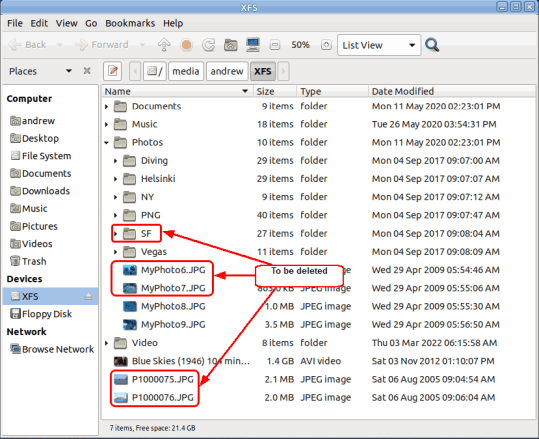
Click image to enlarge
The task: To recover these files and the included folder.
1. Run R-Studio and locate the disk with the XFS partition.
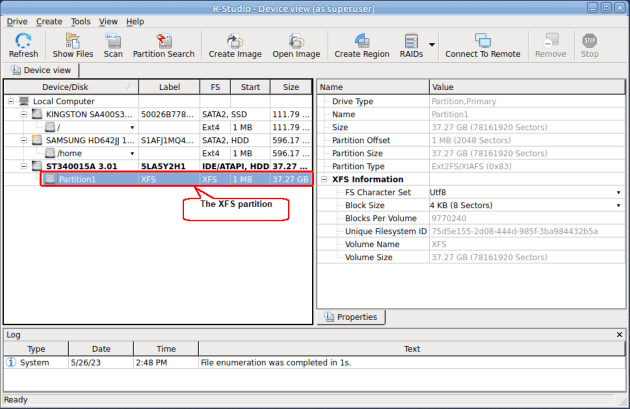
Click image to enlarge
2.Enumerate files on the partition and inspect the file system.
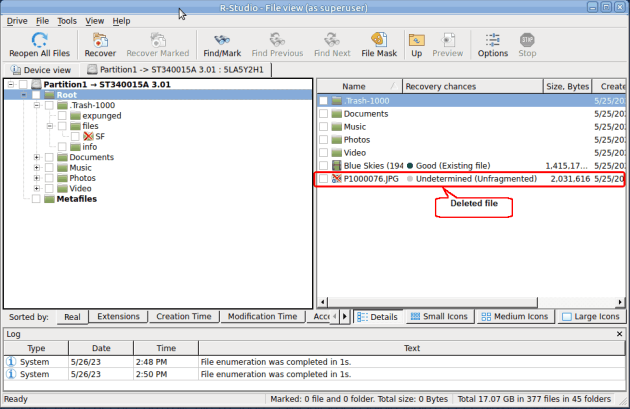
Click image to enlarge
3. Locate the deleted files in the Trash folder.
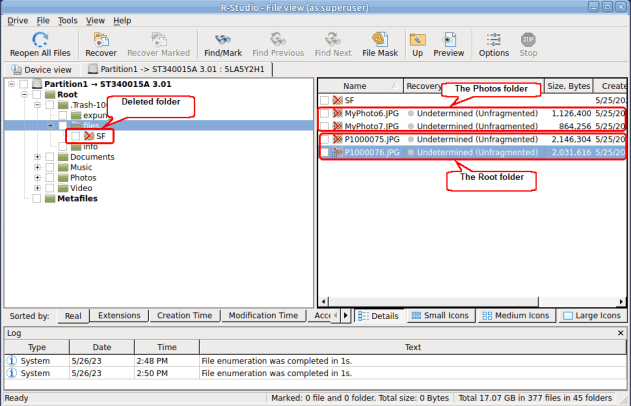
Click image to enlarge
You can preview files by double-clicking them to verify that they aren't broken.
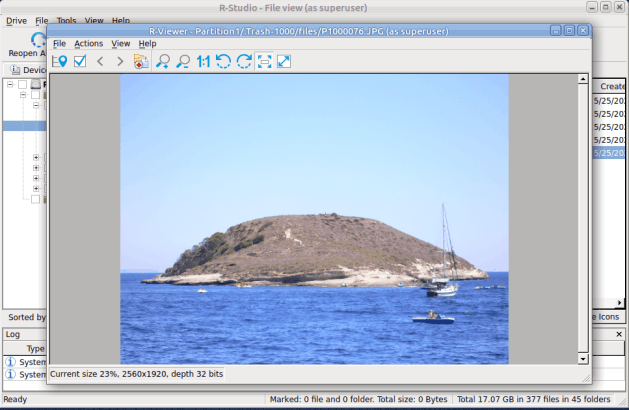
Click image to enlarge
4. Mark the found files for recovery and click the Recover Marked button.
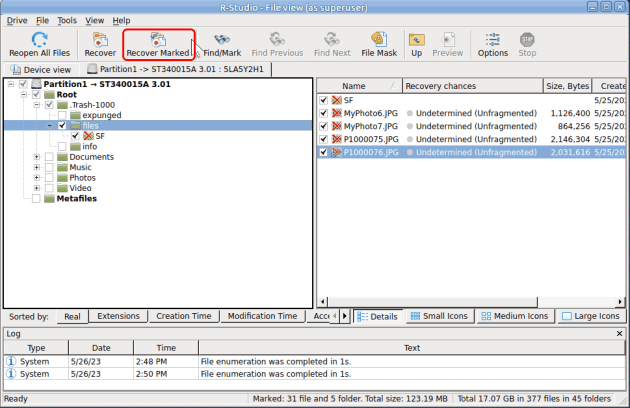
Click image to enlarge
5. Specify the output folder and recovery parameters on the Recover dialog box and click the OK button.
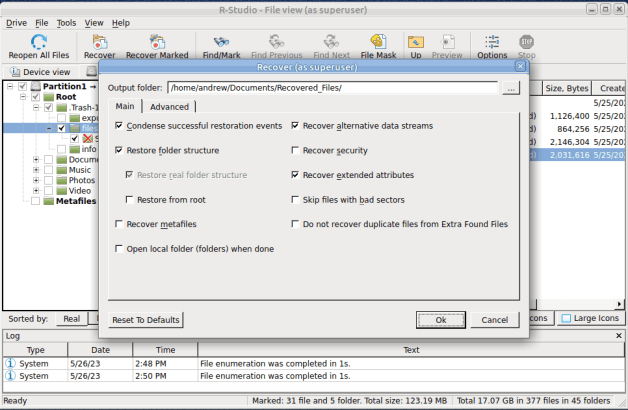
Click image to enlarge
You can find more information about these parameters in R-Studio's online help: Basic File Recovery.
> R-Studio will start the file recovery process. When it's complete, you can see the recovered files and folders in the Output folder.
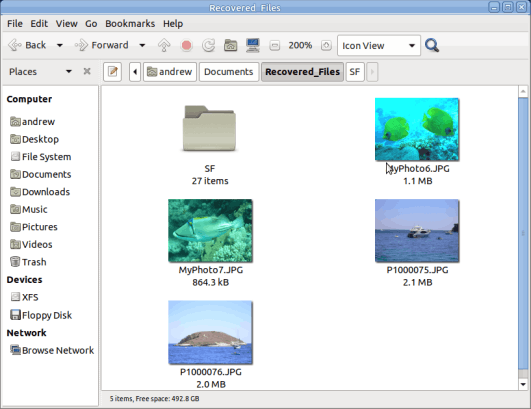
Click image to enlarge
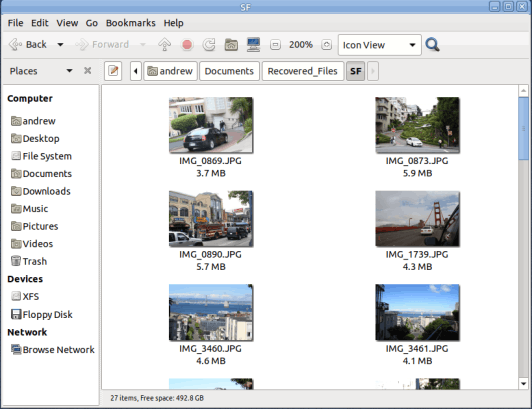
Click image to enlarge
Case 2: An XFS partition was erroneously formatted into a new XFS partition.
The task: To recover files from the lost partitions and its entire folder structure, if possible.
1. Run R-Studio and locate the disk with the new partition.
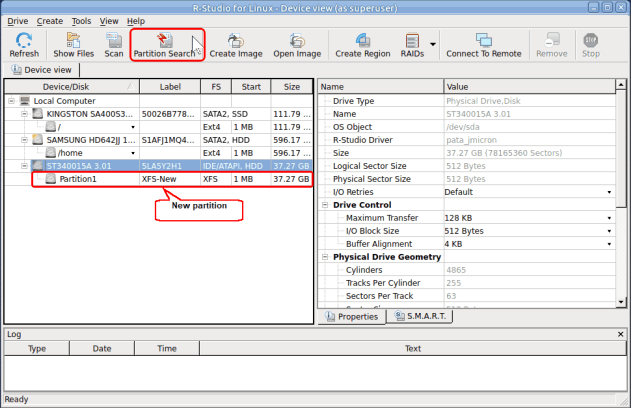
Click image to enlarge
First, we'll try to find the lost partition by using fast search for partition.
2. Click the Partition Search button and wait for the results.
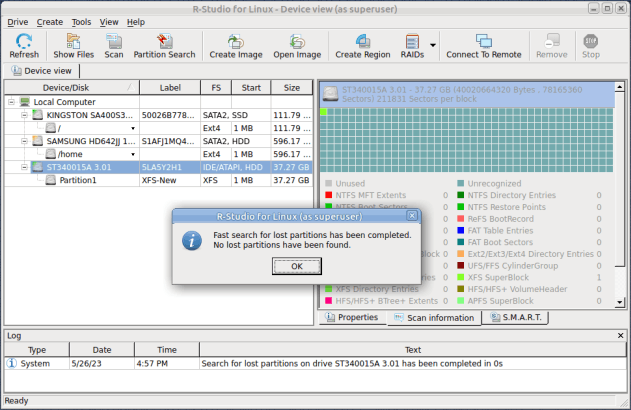
Click image to enlarge
Unfortunately, R-Studio was unable to find the lost partition in our case. Nevertheless, it's always a good idea to start file recovery from lost partitions by using this method. It typically finds them with all their files intact.
Our next step is to scan the entire disk.
3. Click the Scan button and specify scan parameters.
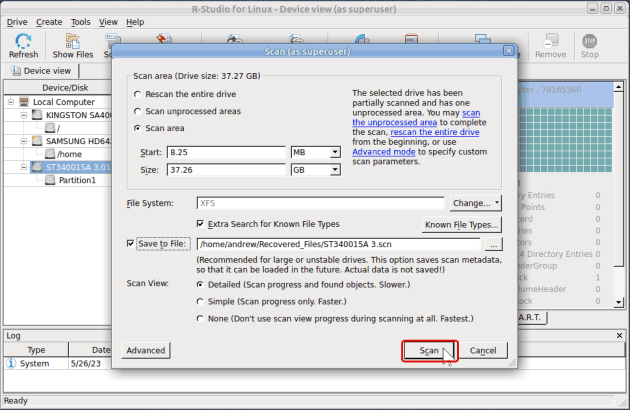
Click image to enlarge
Click the Change button for the File System field, leaving only XFS selected. You can also specify Known File Types (raw files) to search for, depending on the types of files resided on the lost partition. You can read more about these parameters in R-Studio's online help: Drive Scan.
It's also a good idea to save scan info, as it can be necessary to interrupt scan process and resume it later. The saved scan info can be loaded at a later date and the scan will be resumed from the point where it was interrupted.
Click the Scan button when you have specified all the necessary parameters.
> R-Studio will start scanning the disk showing its progress
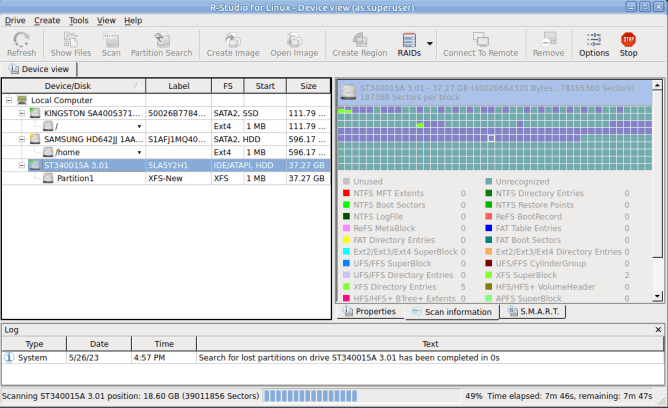
Click image to enlarge
4. Inspect the scan results when the scan is over.
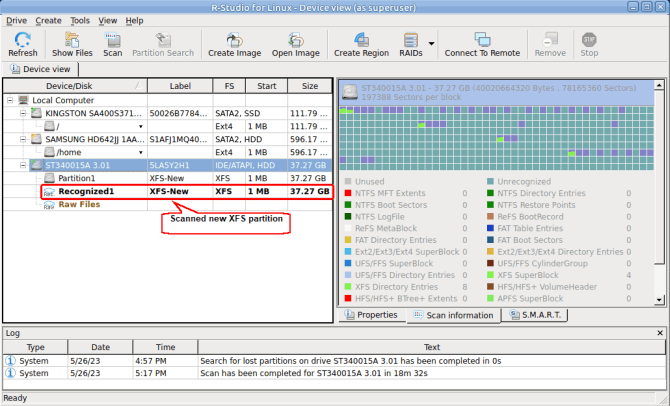
Click image to enlarge
R-Studio couldn't find the lost partition and therefore the only option is to try to search lost files on the scanned new partition.
5. Enumerate files on the scanned partition by double-clicking it and inspect the results.
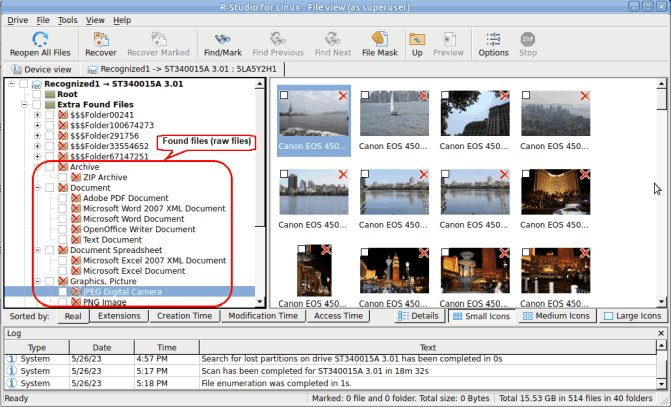
Click image to enlarge
Files from the lost partition are found by their file signatures and placed in the Extra Found Files section. That is why they don't have their original names, and other file attributes might be missing, too. Still, R-Studio tries to give them some meaningful names using their internal tags.
You may also preview files to verify that the files aren't corrupted by double-clicking them.
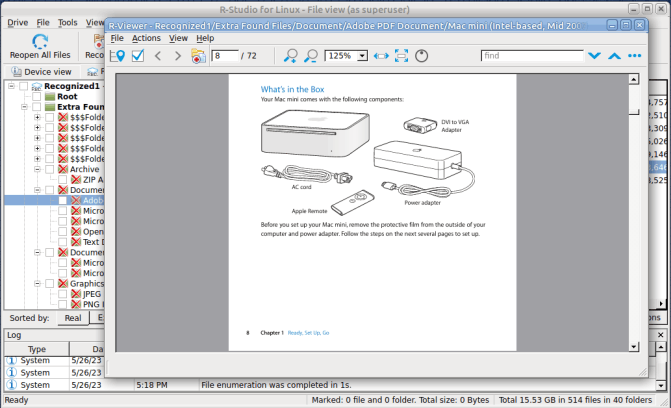
Click image to enlarge
6. Mark files for recovery and click the Recover Marked button.

Click image to enlarge
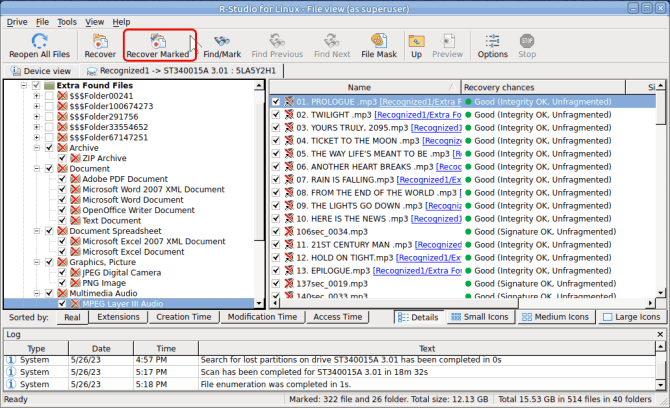
Click image to enlarge
7. Specify recovery parameters and click the OK button.
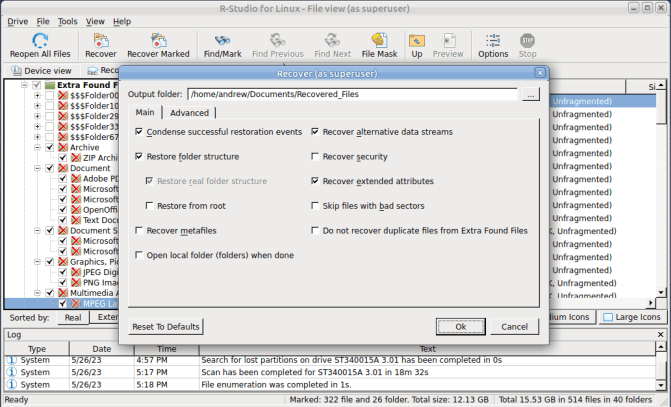
Click image to enlarge
R-Studio will start file recovery showing its progress.
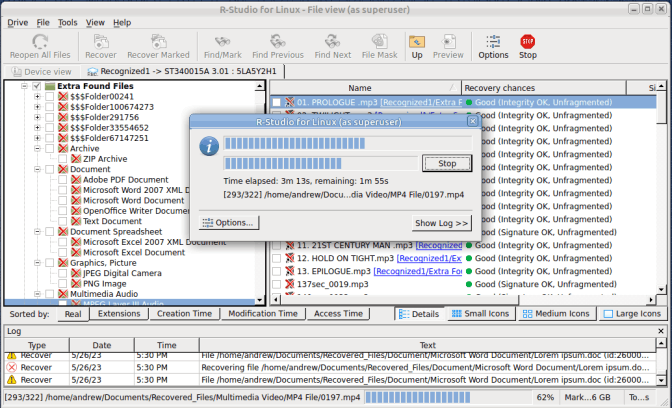
Click image to enlarge
You can see the recovered files when recovery is over.
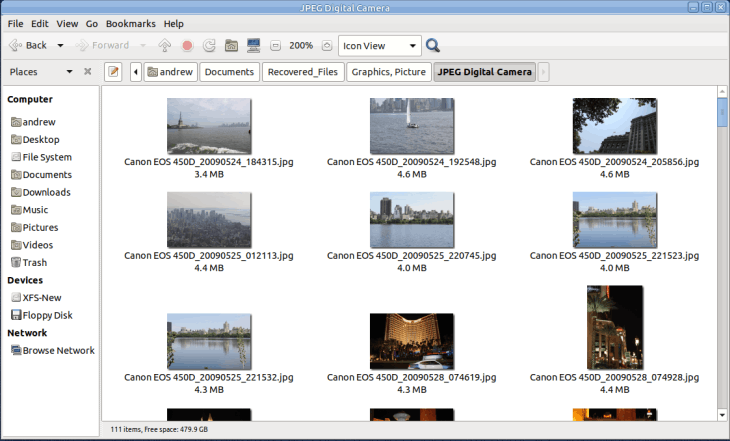
Click image to enlarge
Conclusions
Our tests have shown that R-Studio is able to recover data from XFS disks. In the first case (deleted files), all files and the individual folder have been successfully recovered. In the second case (disk format), all files have been successfully recovered as raw files without their names and other attributes. The entire folder structure has not been recovered at all due to the fact that the metadata of the new partition has been written over the metadata of the old partition.
You may perform all these steps in the demo mode of R-Studio without committing to a purchase. If you can successfully find and preview lost files, you can register your copy of R-Studio and save recovered files.
- R-Studio Technician: activation using a USB stick
- Data Recovery Guide
- Why R-Studio?
- R-Studio for Forensic and Data Recovery Business
- R-STUDIO Review on TopTenReviews
- File Recovery Specifics for SSD devices
- How to recover data from NVMe devices
- Predicting Success of Common Data Recovery Cases
- Recovery of Overwritten Data
- Emergency File Recovery Using R-Studio Emergency
- RAID Recovery Presentation
- R-Studio: Data recovery from a non-functional computer
- File Recovery from a Computer that Won't Boot
- Clone Disks Before File Recovery
- HD Video Recovery from SD cards
- File Recovery from an Unbootable Mac Computer
- The best way to recover files from a Mac system disk
- Data Recovery from an Encrypted Linux Disk after a System Crash
- Data Recovery from Apple Disk Images (.DMG files)
- File Recovery after Re-installing Windows
- R-Studio: Data Recovery over Network
- How To Use R-Studio Corporate Package
- Data Recovery from a Re-Formatted NTFS Disk
- Data Recovery from an ReFS disk
- Data Recovery from a Re-Formatted exFAT/FAT Disk
- Data Recovery from an Erased HFS Disk
- Data Recovery from an Erased APFS Disk
- Data Recovery from a Re-Formatted Ext2/3/4FS Disk
- Data Recovery from an XFS Disk
- Data Recovery from a Simple NAS
- How to connect virtual RAID and LVM/LDM volumes to the operating system
- Specifics of File Recovery After a Quick Format
- Data Recovery After Partition Manager Crash
- File Recovery vs. File Repair
- Data Recovery from Virtual Machines
- How to Connect Disks to a Computer
- Emergency Data Recovery over Network
- Data Recovery over the Internet
- Creating a Custom Known File Type for R-Studio
- Finding RAID parameters
- Recovering Partitions on a Damaged Disk
- NAT and Firewall Traversal for Remote Data Recovery
- Data Recovery from an External Disk with a Damaged File System
- File Recovery Basics
- Default Parameters of Software Stripe Sets (RAID 0) in Mac OS X
- Data Recovery from Virtual Hard Disk (VHD/VHDX) Files
- Data Recovery from Various File Container Formats and Encrypted Disks
- Automatic RAID Parameter Detection
- IntelligentScan Data Recovery Technology
- Multi-pass imaging in R-Studio
- Runtime Imaging in R-Studio
- Linear Imaging vs Runtime Imaging vs Multi-Pass Imaging
- USB Stabilizer Tech for unstable USB devices
- Joint work of R-Studio and PC-3000 UDMA hardware
- Joint work of R-Studio and HDDSuperClone
- R-Studio T80+ - A Professional Data Recovery and Forensic Solution for Small Business and Individuals Just for 1 USD/day
- Backup Articles
- R-Drive Image Standalone and Corporate license transferring
- Fixing Windows update error 0x80070643 with R-Drive Image
- Backup with Confidence
- R-Drive Image as a free powerful partition manager
- Computer Recovery and System Restore
- Disk Cloning and Mass System Deployment
- Accessing Individual Files or Folders on a Backed Up Disk Image
- R-Drive Image startup / bootable version
- File Backup for Personal Computers and Laptops of Home and Self-Employed Users
- Creating a Data Consistent, Space Efficient Data Backup Plan for a Small Business Server
- How to Move the Already Installed Windows from an Old HDD to a New SSD Device and Create a Hybrid Data Storage System
- How to Move an Installed Windows to a Larger Disk
- How to Move a BitLocker-Encrypted System Disk to a New Storage Device
- How to backup and restore disks on Linux and Mac computers using R-Drive Image
- Undelete Articles
- Get Deleted Files Back
- Free Recovery from SD and Memory cards
- R-Undelete: Video Recovery
- Recovery from an External Device with a Damaged File System
- File recovery from a non-functional computer
- Free File Recovery from an Android Phone Memory Card
- Free Photo and Video File Recovery Tutorial
- Easy file recovery in three steps
Rating: 4.8 / 5
R-TT may not be the easiest or most user-friendly solution, but the algorithm used for the renaming saved me THOUSAND of hours of opening ...




